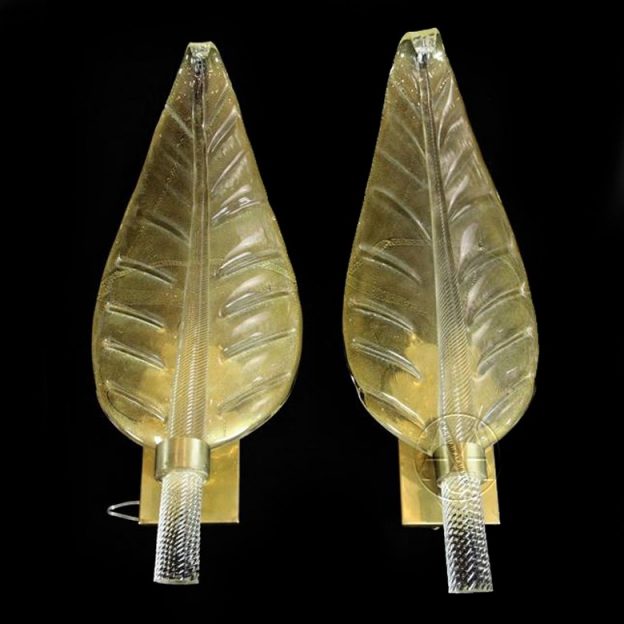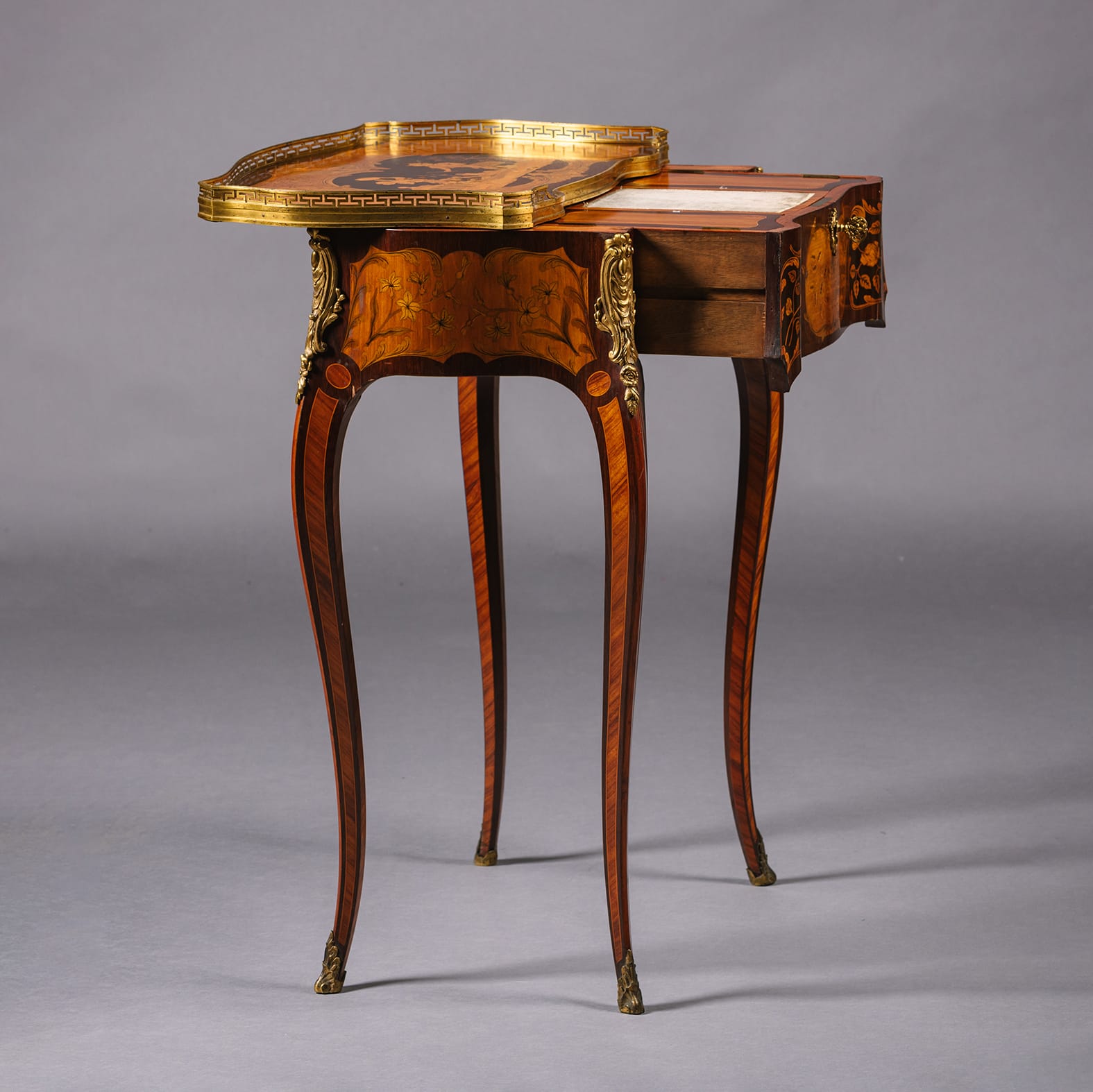Maison Beurdeley
A Fine and Rare Louis XV Style Gilt-Bronze Mounted Marquetry Occasional Table
£22,000
A Fine and Rare Louis XV Style Gilt-Bronze Mounted Marquetry Occasional Table. By Emmanuel Alfred (dit Alfred II) Beurdeley. Paris. France, Circa 1885. The...
Dimensions
Height: 75 cm (30 in)Width: 54 cm (22 in)
Depth: 34 cm (14 in)
Description
A Fine and Rare Louis XV Style Gilt-Bronze Mounted Marquetry Occasional Table. By Emmanuel Alfred (dit Alfred II) Beurdeley. Paris. France, Circa 1885.
The top with marquetry of precious fruitwoods and rare timbers depicting a central cartouche of two monkeys standing in a classical landscape, dressed as men playing a drum and a tambourine. The surrounding marquetry composed of rocaille framed trellis parquetry panels with musical attributes. The shaped top surrounded by a three-quarter gilt-bronze gallery. The top slides back and the drawer opens to reveal a writing tray. The serpentine sides with cartouches with flower-filled marquetry. On cabriole legs headed by gilt-bronze rocaille clasps.
Beautifully rendered by Beurdeley this ‘table Singeries’ is ennobled with the fullest frivolity of the rococo. The marquetry scene on the top derives from engravings published in Paris in the mid-eighteenth century entitled ‘Le Tambour de Basque’ and ‘Le Tambourin’ by J. Guelard after designs by Christophe Huet (died 1759) from a series entitled ‘Singeries ou Différentes Actions de la Vie Humaine Representées par des Singes’.

‘Le Tambourin’, engraving by J. Guelard, from a series entitled ‘Singeries ou Différentes Actions de la Vie Humaine Representées par des Singes’.
The present writing table is almost identical to an 18th century table in the James A. de Rothschild collection at Waddesdon Manor (inv. 3472) which was purchased by Baron Ferdinand de Rothschild at the legendary auction of Prince Demidov’s Florentine Palazzo San Donato in 1880 (Lot 1554 — Très jolie table a ouvrage en marqueterie de bois colorés du temps de Louis XV, avec motif principal reproduisant deux gravures de Huet: le Singe musicien et le Singe danseur. Elle est de forme très gracieuse et ornée de bronzes dorés et d’une galerie ajourée).
It is possible that Alfred Beurdeley admired the Demidov table at the 1880 San Donato sale and it inspired him to develop the present model. Beurdeley is recorded to have made this model of table more than once, although fewer than four examples are known.
Stamped ‘A. BEURDELEY A PARIS’.
France, Circa 1885.
Date
Circa 1885
Origin
France
Medium
Marquetry and Gilt-Bronze
Signature
Stamped ‘A. BEURDELEY A PARIS’.

Emmanuel-Alfred (dit Alfred II) Beurdeley (1847-1919)
The Beurdeley family were a flourishing dynasty of three generations of fine quality cabinetmakers working from 1818 to 1895. The firm was particularly well known for its exceptional metalwork, most commonly basing their designs on important eighteenth century examples. Their mercurial gilding and hand chasing are often of such a high standard that it is difficult to distinguish them from late eighteenth century work.
The founder of the dynasty Jean Beurdeley (1772-1853) was a Burgundian craftsman conscripted into the Napoleonic army. After hostilities ended in 1815 he settled in Paris opening a shop for curiosités and working as a latter day marchand mercier. Initially based on the rue Saint-Honoré, in 1840 Beurdeley moved to the famous Hanover Pavilion situated on the corner of rue Louis-Legrand and boulevard des Italiens, and the business was run by his only surviving son, Louis-Auguste-Alfred (1808-1882). This successful business, which had numerous official commissions including in 1853 the marriage coffer for the Empress Eugénie, was continued by Louis’ son, Alfred-Emmanuel-Louis (1847-1919).
The business continued in its traditional style with very few variations until 1895. Alfred, along with the most famous artists of the period, took part in the 1878 Paris Exposition Universelle where he won the gold medal. Following on from this glory, he went on to open a shop in New York.
His participation in the 1883 Amsterdam Universal Exhibition drew even further attention to his work, and possibly as a result he was awarded the Ordre National de la Légion d’Honneur, France’s highest official mark of recognition.
The incredible quality of each generation’s work ranked the firm of Beurdeley as pre-eminent amongst Parisian makers of meubles de luxe.
Bibliography:
Ledoux – Lebard, Denise. Les Ébénistes du XIXe siècle, Les Editions de L’Amateur, (Paris), 1984; pp. 75-82.
Mestdagh, Camille & Lécoules, Pierre. L’Ameublement d’Art Français, 1850-1900, Les Editions de L’Amateur, (Paris), 2010; pp.262-276.
Meyer, Jonathan. Great Exhibitions – London, New York, Paris, Philadelphia, 1851-1900, Antique Collectors’ Club, (Woodbridge, UK), 1984 ; pps. 175, 247, 269, 270, 290, 298.
Collection Pierre Lecoules.
Identical writing tables by Alfred Beurdeley are illustrated in Pierre Ramond, ‘Masterpieces of Marquetry from the Régence to the present day’, vol II, editions H. Vial, 2000, p. 60, and Denise Ledoux-Lebard, ‘Les ébénistes du XIXe siècle 1795-1889’, Les éditions de l’Amateur, Paris, 2000 (colour supplement III).












 Print
Print


